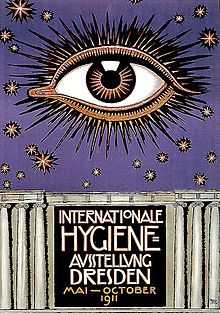International Hygiene Exhibition

The International Hygiene Exhibition was a world's fair focusing on medicine and public health, held in Dresden, Germany, in 1911.[1]
The leading figure organizing the exhibition was German philanthropist and businessman Karl August Lingner, who had grown wealthy from his Odol mouthwash brand, and was enthusiastic about educating the public about advances in public health. Lingner had previously organized a public-health exhibition as part of the 1903 Dresden municipal expo, and its success led him to plan a larger endeavor.[1]
The exhibition opened on May 6, 1911, with 30 countries participating, 100 buildings built for the event, and 5 million visitors over its duration. It emphasized accessible visual representations of the body, and a particular sensation were the transparent organs preserved and displayed according to a method devised by Werner Spalteholz.[1]
Following the exhibition, its contents became the permanent German Hygiene Museum in Dresden. Its success spawned several follow-up expos, most notably the 1926 "Gesolei" exhibition in Düsseldorf.[1]
Other International Exhibitions of Hygiene were held in:
- 1910: Buenos Aires, Argentina:[2] Exposición Internacional del Centenario (1910)
- 1913: Lima, Peru[3]
- 1914: Genoa, Italy[4]
References
- ↑ 1.0 1.1 1.2 1.3 Klaus Vogel (2004). "The Transparent Man — Some comments on the history of a symbol". In Robert Bud. Manifesting Medicine. National Museum of Science and Industry. pp. 36–38. ISBN 1-900747-56-1.
- ↑ John Barrett, ed. (1910). Bulletin of the Pan American Union XXXI. Union of American Republics. pp. 26, 429–431.
- ↑ John Barrett, ed. (1914). Bulletin of the Pan American Union. XXXVIII. Union of American Republics. p. 151.
- ↑ John Barrett, ed. (1914). Bulletin of the Pan American Union. XXXVIII. Union of American Republics. p. 606.
| Wikimedia Commons has media related to Dresden 1911 hygiene exhibition. |